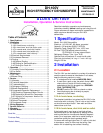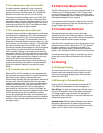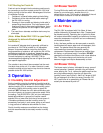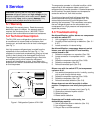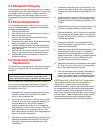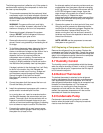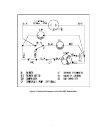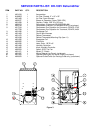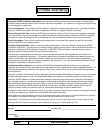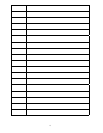2.1C In remote area, duct inlet & outlet.
It is often desirable, especially in pool rooms and
finished areas, to install the DH-100V in an adjacent
equipment room or unfinished area. Air is transferred
between the humid room and the unit via ducting.
The factory mounted humidity control on the DH-100V
cabinet may not sense the humidity in the humid room
accurately enough with this installation method. If so, an
additional humidity control can be mounted in the humid
room and wired to the DH-100V. Local electrical codes
must be followed when wiring the control.
2.1D In remote area, duct outlet only.
A simpler remote installation method than the one above
uses ducting only between the DH-100V discharge and
the humid room; the DH-100V inlet draws air from the
room in which it's located. This works well if there is an
adequate air flow path between the two rooms; e.g., high
door undercut, louvered door or wall grill. This eliminates
the need to remote mount the humidity control. There
are several potential disadvantages to using this method.
First, humid air is drawn into the room where the DH-
100V is located. Second, to accurately sense humidity,
the blower in the DH-100V may need to run continuously
to draw air from the humid room into the DH-100V room.
Third, a slight negative pressure is created in the room
with the DH-100V which could back draft open
combustion devices located there. If such devices are
present, call the factory for specific instructions before
using this installation method or consider the option
below.
2.1E In remote area, duct inlet only.
When the DH-100V is located in a room separate from
the main area to be dehumidified, it may be desirable to
dehumidify and/or slightly pressurize that room.
Pressurization assures that open combustion devices do
not back draft, as would be the case if the room were
sufficiently depressurized. This can be accomplished by
installing a duct from the humid room to the DH-100V
inlet and by allowing the DH-100V to discharge the
dehumidified air into the room in which it's located. An
adequate airflow path must exist between the two rooms
for this method to work well. An additional humidity
control may need to be mounted in the humid area and
wired to the DH-100V to accurately maintain the desired
humidity. Local electrical codes must be followed when
wiring the control.
2.2 Electrical Requirements
The DH-100V plugs into a common grounded outlet on a
15 Amp circuit. It draws between 6 and 7 Amps under
normal operating conditions. If used in a wet area (pool,
spa room, or basement prone to flooding), a ground fault
interrupter protected circuit is required.
If an extension cord is required, it must have a minimum
of 16 gauge conductors if less than 25 feet long and 14
gauge if greater than 25 feet.
2.3 Condensate Removal
Condensate drains by gravity via the clear hose
extending from the unit. Route the hose to a floor drain.
Use care to keep the hose as flat to the floor as possible.
Excessive humps will prevent proper drainage.
If the DH-100V is located too far from a floor drain for the
attached hose to reach, inexpensive 1/2" PVC pipe can
be used to extend it. It is commonly available in 10'
lengths from building supply, plumbing and hardware
stores. It will slide tightly inside the end of the drain hose.
If more than one length of pipe is required, they can be
joined with a short piece cut from the end of the drain
hose.
2.4 Ducting
2.4A Optional Ducting
An inlet shroud with a 8" round collar and an 8" round
exhaust collar are available from the factory that will
allow round ducting to be attached to the inlet and/or
outlet of the DH-100V.
2.4B Ducting for Dehumidification
Ducting the DH-100V as mentioned in sections 2.1B-
2.1E requires consideration of the following points:
Duct Sizing: For total duct lengths up to 25 feet, use a
minimum 8" diameter round or equivalent rectangular.
For longer lengths, use a minimum 10" diameter or
equivalent. Grills or diffusers on the duct ends must not
excessively restrict airflow.
Isolated Areas: Effective dehumidification may require
that ducting be branched to isolated, stagnant areas.
Use 6" diameter branch ducting to each of two or three
areas, use 4" to each of four or more areas.
2



